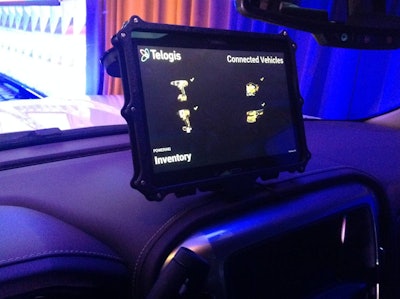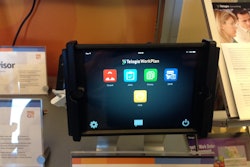 CLICK HERE to see a photo gallery of events from the 2014 Telogis Latitude user conference.
CLICK HERE to see a photo gallery of events from the 2014 Telogis Latitude user conference.During the Telogis Latitude user conference, held Oct. 27-29 in Dana Point, Calif., Newth Morris announced a set of cloud-based applications fleets can use to move their “supply and service chains” to the next generation in value creation.
The first generation started by connecting people, devices and vehicles to the “Internet of Things,” said Morris, co-founder of Telogis and president of Telogis Route and Navigation.
Connectivity has created value in even the most simple supply chains, he noted. A fisherman in India, for example, used to come ashore before deciding whether to sell his catch to a broker or take his chances and go to the market.
At the market, the fisherman had limited time to shop around for the best price due to the perishable commodity. Cell phone connectivity made it possible to call ahead, from the boat, to find the best price and take the catch directly to market.
“The first point of connectivity has fundamentally changed his business and quality of life,” he said.
Telogis’ software-as-a-service (Saas) platform is used by fleets to connect with approximately 400,000 vehicles today. The platform gives Telogis customers access to all of the data from vehicles’ electronic control modules, sensors, cameras, wearable devices on drivers and more, he said.
“We are in a moment where there is the opportunity to have 100 percent connectivity,” he said. “We have vehicles and not only vehicles but everything that’s on a vehicle.”
The connected vehicle can be combined with powerful mobile computing devices such as smartphones. Now fleets can stay connected to every vehicle and employee to automate whatever business process they want, he said.
 CLICK HERE to view a photo gallery of the Telogis 2014 user conference. This demonstration shows how technology can be used to track inventory of work tools on a truck.
CLICK HERE to view a photo gallery of the Telogis 2014 user conference. This demonstration shows how technology can be used to track inventory of work tools on a truck.“The challenge is no longer connecting things,” he explained. “We exist in the days where there is ubiquity of connectivity. The challenge is in moving from connectivity and connections to orchestration.”
Orchestration, he went on to say, involves the use of super computing power in the cloud to solve complex and dynamic routing problems. The result is people and products getting to the right place, at the right time, in the safest and most efficient way possible.
To achieve this goal, Telogis has developed the following applications for its SaaS platform.
Telogis Sites. This feature previously existed in Telogis’ commercial navigation application and is now available for all of its routing products. With Sites, users can fine-tune their final mile routing to improve efficiency and safety. Specific route instructions for the ingress and egress at each stop location can be added to route plans.
Telogis Curated Sites. This application gives users access to final mile, site-specific route directions that have been created from other users. Examples include the ingress and egress from certain manufacturing plants, retail locations and gas stations.
Telogis Quick Route. An “easy on ramp” for businesses to start using Telogis’ route optimization platform by importing customer stop data, plan routes, and then push routes out to the field through a single, intuitive online interface.
Telogis Navigation 6.0. The latest version of Telogis’ commercial navigation app has been rebuilt from the ground up to leverage Apple and Android operating systems and to take advantage of more dynamic data such as lane guidance.
Telogis Control Room. This app gives users real-time visibility to how their route plans are progressing and supports dynamic data for traffic, weather and customer-specific parameters.
Telogis Dispatch. This tool leverages all of the technology of Telogis Control Room and Telogis’ route optimization engine to assist dispatchers with responding to changes throughout the day. The company’s goal is to enable a single dispatcher to manage as much as 100 vehicles, Morris said.
Major data elements have also been added to Telogis’ routing products to report more details of planned versus actual route performance.
[CLICK Here to view a picture tour of the speakers and technology demonstrations at the 2014 Telogis Latitude conference]
Morris and other Telogis executives mentioned several companies as examples of next-generation value creation in supply and service chains. These companies use technology to give their customers more freedom, convenience and instant gratification.
The ride sharing service, Uber, has an app consumers use to choose a driver and compare prices in advance. This on-demand service is a clear threat to the taxi cab industry which offers little, if any, visibility and connectivity.
 Aaron Peele, outbound logistics manager for Door to Door Organics, speaks at the Telogis Latitude conference on Oct. 28. CLICK on the photo to view a gallery of other events.
Aaron Peele, outbound logistics manager for Door to Door Organics, speaks at the Telogis Latitude conference on Oct. 28. CLICK on the photo to view a gallery of other events.One of Telogis’ customers, Door to Door organics, is using routing tools to gain a competitive advantage in the online grocery business which is projected to grow from 3.3 to 10 percent of the $500 billion grocery market in the next 10 years.
Door to Door Organics does not just deliver groceries; the company is all about “empowering people to eat good food.”
Founded in Boulder, Co., in 2005, the company now delivers in 30 major cities in 11 states from its five distribution centers. Its revenue is growing by 43 percent every year and is on pace to increase from $35 million in 2014 to $50 million in 2015, said Aaron Peele, outbound logistics manager.
The company is beating its competition, like Amazon Fresh, by giving customers a curated experience.
“We don’t charge delivery fees. We have a subscription model,” Peele explained. Customers sign up for weekly or bi-weekly deliveries. From they day they receive their order, customers have up to five days to select their next order. The cutoff is at noon on the day before their scheduled delivery.
The company will soon introduce an option to allow customers to place orders for same-day deliveries for a small fee. Its order volume has increased 20 percent from last year, he said, but labor costs in its logistics department have come down by over 10 percent due to the efficiency of its route planning process. These efficiency gains will help with its expansion next year and beyond, Peele says.











